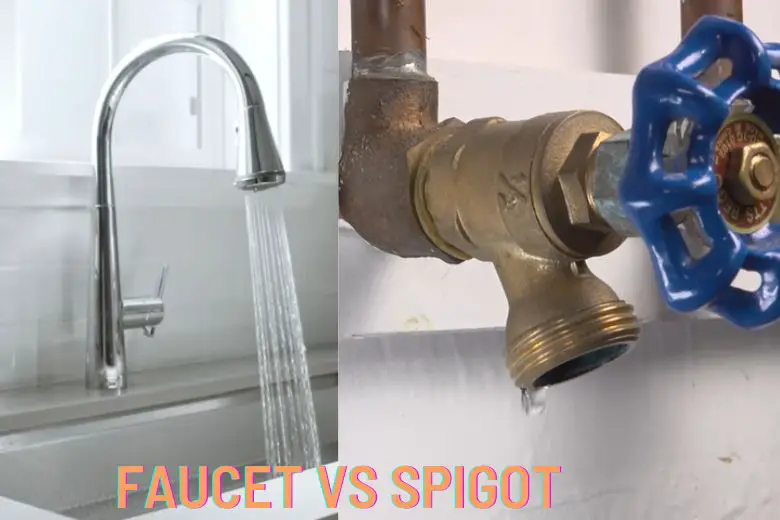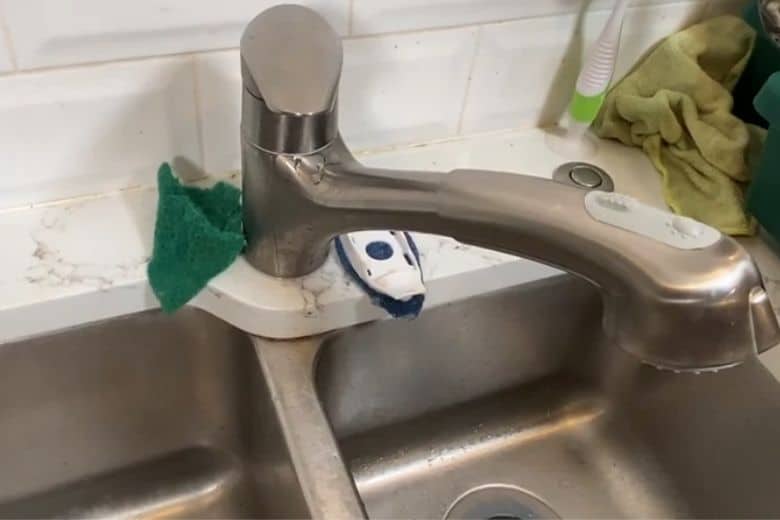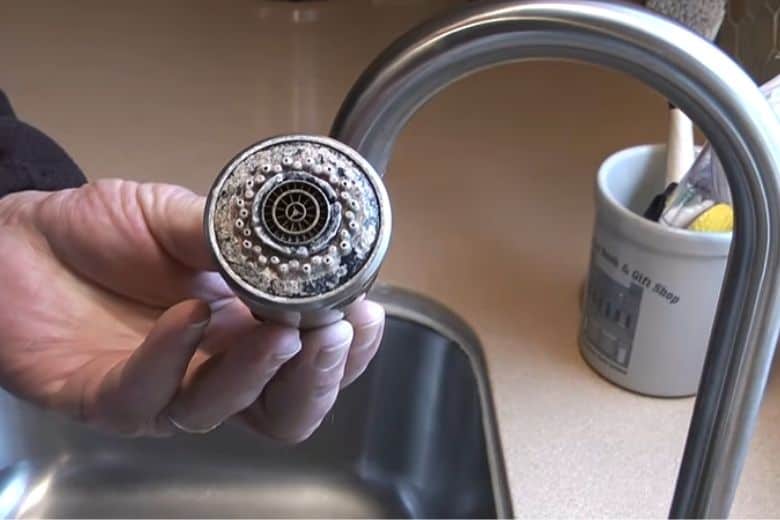A Faucet, tap, spigot, and spout are all used to work for flowing water to your kitchen, bathroom, shower, sink, etc. Whether for a home, hotel, office, outdoor, garden, or commercial place. Then you might wonder what the difference is and why so many options are available.
Let’s us clear!
Although all are them are meant to build for flowing water. Still, each category has visible differences in design, feature, functionality, and working area.
Eventually, today we have focused between faucet vs spigot due to their super inquiry. Bear with us to get details about faucets and spigots and learn why they are called by a different name and where you can use them.
Without further delay, let’s begin with the definition of both devices.
Definition of a Faucet
To begin with, we have included the faucet definition, also known as a tap, in many places. Generally, the term “faucet” is used primarily in the US, whereas tap is in British English. Both taps and faucets are used in the bathroom, kitchen, shower, or another place, but some call them faucets, and others may know it as a tap.
Whether you call it a faucet or, in British English tap, it is a device used to control water flow.
However, a faucet is typically installed on sinks, bathtubs, and showers and comes in various styles and finishes. Several types of faucets are available, each with its advantages and disadvantages. Ha
1. Ball Faucet:
Ball faucet is famous for use in kitchen or bathroom sinks. It is a single-handle latest design faucet using a rotating ball with specially designed slots or holes to regulate the water flow. The ball is usually made of metal or plastic. Its handle rotates the ball to control the water flow and temperature.
It is a trendy and modern design faucet that is very easy to use and offers a sleek and minimalist appearance.
2. Cartridge Faucet:
On top of other faucets, the cartridge faucet is super famous. It is the most used faucet in residential and commercial places. It features a double-handle design and compresses a rubber washer against a valve seat to control the water flow.
The cartridge is made of ceramic, plastic, or metal, and it regulates water flow by moving up and down or side to side. However, it uses a replaceable cartridge, so it offers easy replacement.
3. Disc Faucet:
Moving to the following categories, we have presented another famous faucet: the disc faucet. Like a ball faucet, it is also structured in a single-handle pattern with two ceramic discs to control the water flow. It can be operated by one or two handles and is durable and reliable.
They also offer smooth and precise flow control, allowing for easy and accurate temperature and water pressure adjustments. They are made of durable ceramic materials resistant to wear and tear.
4. Compression Faucet:
The last faucet in our categories is a compression faucet. This type of faucet has two handles and compresses a rubber washer against a valve seat to control the water flow. Compression faucets were once the most common type of use at home.
You can quickly identify a compression faucet by the individual cold and hot water handles.
Advantage of Faucet
- Faucets are available in various styles and finishes, making it easy to find one that matches your home décor.
- They are easy to use and provide a steady stream of water at the desired temperature.
- Many faucets are designed to conserve water, which can help reduce your water bill.
- can add value to your home and make it more attractive to potential buyers.
Disadvantage of Faucet
- Faucets can be expensive to replace if they develop a problem.
- Some types of faucets, such as compression faucets, require regular maintenance to prevent leaks.
- If your faucet develops a leak, it can waste a significant amount of water and increase your water bill.
Cost of Faucet
The cost of a faucet can vary depending on the type, brand, and style. Generally, compression faucets are the least expensive. In contrast, cartridge and disc faucets are mid-range, and ball faucets can be the costly.
The installation cost can also vary depending on whether you hire a plumber or do it yourself. On average, a faucet ranges from around $20 for a basic compression faucet to $200 or more for a high-end ball faucet.
Installation costs can range from $50 to $300 or more, depending on the complexity of the installation and the plumber’s hourly rate.
Definition of Spigot:
The spigot, known as a hose bib, bibcock, or outdoor faucet, is a type of valve used to control the flow of water from a pipe or water supply to an external location. It is typically located outside a building and connects hoses for gardening, washing cars, and other outdoor activities.
A spigot is made of durable materials such as brass, stainless steel, or plastic and design to withstand outdoor elements such as rain, wind, and extreme temperatures.
Spigots are operated by turning a handle or knob to open or close the valve, allowing water to flow or shutting it off completely. Some spigots also have a built-in anti-siphon valve, which prevents the backflow of water into the supply pipe and helps protect against contamination of the water supply.
On the contrary to a faucet, a spigot is less fancy in design, feature, and functionality. It has no hot and cold-water features and lacks a modern, sleek, and finest finish.
Spigots are commonly used in residential and commercial settings, particularly for outdoor watering applications.
There are four main types of spigots:
1. Compression Spigot:
A compression spigot mainly attaches a water supply line to a faucet. It consists of a threaded nut tightened over a compression ring, creating a watertight seal. Compression spigots are also commonly used in outdoor plumbing applications, such as connecting a garden hose.
Compression spigots are versatile plumbing fittings used in various applications, including the kitchen under the sink.
2. Ball Valve Spigot:
A ball valve spigot uses a ball valve to control the water flow. The ball valve has a hole through the center that can be turned to allow water to flow through or shut off the flow completely.
It is commonly used in plumbing applications where a high degree of control over the water flow is needed. They are often used in industrial settings, such as factories or manufacturing plants, where precise control over water flow or other liquids is necessary.
Ball valve spigots are also used in irrigation systems. They allow precise control over the water flow to different parts of a field or garden. Additionally, ball valve spigots are often used in residential plumbing applications, such as for outdoor faucets or in areas where a high degree of durability and reliability is desired.
3. Sillcock Spigot:
Another sort of spigot is a sillcock, and it is installed on the outside of a house or building. It is designed to provide water to an outdoor area where water needs to be supplied to an outdoor faucet. Sillcock spigots have a long handle that can be turned to open or close the valve.
Similar to a ball valve spigot, it is structured to provide water to a garden hose or other outdoor watering equipment. Therefore, they are often used in residential settings, such as homes with gardens or yards, and commercial locations like parks or public spaces.
Besides, commonly used in agricultural settings, such as on farms or in nurseries, where watering equipment needs to be connected to a reliable water source. Overall, sillcock spigots are specialized plumbing fittings designed for outdoor use.
Consequently, it provides water for gardening, washing cars, and other outdoor activities.
4. Hose Bib Spigot
Hose bib spigots, also known as outdoor faucets or hose spigots, are commonly used in plumbing applications where water needs to be supplied to an outdoor area. They are similar to sillcock spigots, but are typically installed closer to the ground and are designed to provide water to a garden hose or other outdoor watering equipment.
Hose bib spigots are often used in residential settings, such as in homes with gardens or yards, and in commercial locations like parks or public spaces. They are also commonly used in agricultural settings, such as on farms or in nurseries, where watering equipment needs to be connected to a reliable water source.
Overall, hose bib spigots are versatile plumbing fittings designed for outdoor use.
Advantage of Spigot
- Spigots are easy to use and provide a convenient water source for outdoor activities.
- They can water gardens and lawns, wash cars, and fill swimming pools.
- Spigots are durable and can last for many years with proper maintenance.
- They can be replaced relatively quickly if damaged or worn out.
Disadvantage of Spigot
- Spigots can be prone to leaks if they are not installed correctly or if they become worn out over time.
- They can be challenging to repair if they develop a problem.
- If a spigot is installed in a cold climate, it can freeze and burst during winter, causing extensive damage to pipes and fixtures.
Cost of Spigot
The cost of a spigot can vary depending on the type, brand, and style. Generally, outdoor fixtures are less expensive than indoor spigots. The installation cost can also vary depending on whether you hire a plumber or do it yourself.
On average, a spigot ranges from around $10 for a primary outdoor spigot to $50 or more for a high-end indoor spigot. Installation costs can vary from $50 to $300 or more, depending on the complexity of the installation and the plumber’s hourly rate.
Comparison of Faucet vs Spigot
While faucets and spigots provide a water source, the two have several key differences.
1. Design:
Faucets are designed for indoor use and come in various styles and finishes to match your decor. They typically have a lever or knob that controls the water flow and temperature. On the other hand, Spigots are designed for outdoor use. They are typically made of metal with a handle controlling the water flow.
2. Water Flow:
Faucets typically provide a steady, controlled stream of water suitable for washing dishes, hands, and other indoor activities. Spigots, on the constant, are designed to provide a high-volume water flow for outdoor activities like watering gardens, washing cars, and filling swimming pools.
3. Usage:
Faucets are primarily used for indoor activities like washing dishes, hands, and other tasks requiring a controlled water flow. However, spigots are designed for outdoor activities like gardening, washing cars, and filling swimming pools.
4. Installation:
Faucets are typically installed indoors and require a water supply and drain connection. They can be installed by a plumber or someone with basic plumbing skills. Therefore, spigots are installed outside a building and require a link to a water supply. They can be installed by a plumber or by someone with basic plumbing skills.
5. Maintenance:
Faucets require regular maintenance to ensure they operate correctly and prevent leaks. These include cleaning the aerator, replacing washers and O-rings, and tightening loose parts.
Spigots also require regular maintenance to prevent leaks and ensure they operate correctly. It includes cleaning the spigot, checking for leaks, and tightening loose parts.
Note:
In summary, faucets are designed for indoor use and provide a controlled stream of water for tasks like washing dishes and hands. At the same time, spigots are intended for outdoor use and offer a high-volume flow of water for activities like gardening, washing cars, and filling swimming pools.
Both require regular maintenance to prevent leaks and ensure proper operation.
Faucet vs Spigot Which One Do You Need?
Spigot or faucet which one you need entirely depends on your need. Meanwhile, when deciding between a faucet and a spigot, several factors remain that you must consider before the final approach.
Your Using Motive:
The first thing you need to consider, for what you will be using the water source. A faucet would be the better choice if you primarily need a controlled water flow for indoor tasks. On the other hand, if you need a high-volume flow of water for outdoor jobs, a spigot would be the better choice.
Using Location:
Secondly, be sure where the water source will be located. A faucet will be the better indoor choice for washing dishes and hands. But in case of outdoor use like watering a garden, washing a car, or filling a swimming pool, a spigot is the best choice.
Budget:
Thirdly, check your budget for the project. Faucets can be more expensive than spigots, especially if you choose a high-end model.
Installation Process:
Lastly, you should consider the ease of installation. While someone with basic plumbing skills can install both, spigots are typically easier to install since they don’t require a connection to a drain.
Frequently Asked Questions
What is the difference between a faucet and a spigot?
Answer: A faucet is typically used indoors for sinks and has multiple types, including compression, cartridge, ball, and disc. A spigot is typically used outdoors for hose attachments and is generally categorized as outdoor or indoor.
Can I use a spigot instead of a faucet in my kitchen?
Answer: While it is technically possible, using a spigot instead of a faucet in a kitchen is not recommended, as it is not designed for indoor use and may not meet code requirements.
Can a faucet be used outdoors?
Answer: You can use a faucet outdoors, but there may be more practical options. Indoor faucets are not designed to withstand outdoor weather conditions and may not have the necessary connections for outdoor use.
Conclusion
Generally, no one is a winner or loser in comparing faucet vs spigot since both devices are different in design, feature, and functionality. Finally, depending on your need, you can choose any of them because both work great in their field.
Paul Newman is a blogger who writes about plumbing and home improvement. Over the past 20 years, I have worked as a plumber. My passion is to share my knowledge and experience with others to improve their homes.




